The 16 Fastest Dinosaurs: The Speed Demons of the Mesozoic
Many dinosaurs, despite their formidable size, evolved adaptations that prioritized speed. These dinosaurs were typically smaller and more agile. This enabled them to hunt effectively and evade predators, playing critical roles in their ecosystems. This article examines the fastest dinosaurs from the Mesozoic era, exploring their anatomical structures, behaviors, and ecological significance.
In This Article
1. Sinocalliopteryx: “Chinese Beautiful Feather” (Estimates N/A)

Sinocalliopteryx pair feeding on a Sinornithosaurus. Credit: Cheung Chungtat/Wikimedia Commons
Sinocalliopteryx, a theropod from Early Cretaceous China, was a fast-moving predator, based on its skeletal structure. While exact speed estimates are not available, its long limbs and lean build suggest it was capable of bursts of rapid movements.
Known primarily from several well-preserved fossils, Sinocalliopteryx sports a relatively long tail and proportionately large legs. This dinosaur is found to have preyed on smaller vertebrates, such as Sinornithosaurus or Confuciusornis, possibly employing a strategy of pursuit or ambush. Its feather-like structures also suggest it may have had additional capabilities, such as improved thermoregulation or even aiding in maneuverability.
2. Saurornithoides: “Lizard Bird Form” (Estimates N/A)
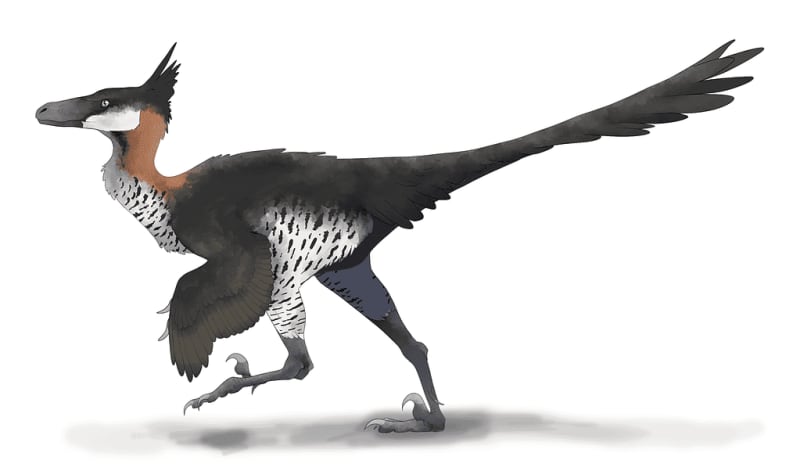
Artist’s recreation of Saurornithoides. Credit: Audrey.m.horn/Wikimedia Commons
Saurornithoidesis a theropod dinosaur from Late Cretaceous Mongolia known for its agility. This dinosaur belonged to the Troodontidae family, characterized by bird-like builds, smarts, and keen senses — adaptations for a lifestyle that required quick reflexes and sharp movements.
Saurornithoides had a lightweight, streamlined body, long legs, and a large brain relative to its size. Its feet featured a sickle claw, similar to dromaeosaurids, which it may have used in capturing prey or climbing. Saurornithoides‘ overall anatomy suggests it was an active predator or omnivore, feeding on small animals and possibly plants.
3. Megalosaurus: “Great Lizard” (32 km/h)
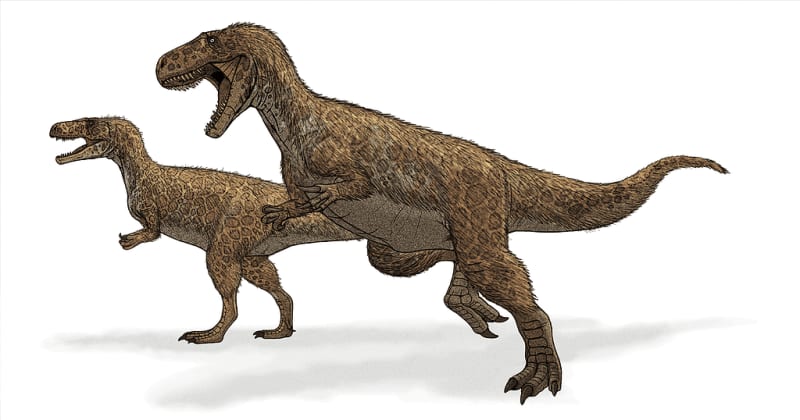
Artist’s recreation of Megalosaurus. Credit: LadyOfHats/Wikimedia Commons
Megalosaurus, the first known dinosaur, was a powerful theropod from Middle Jurassic Europe. Paleontologists estimate the genus to have reached a speed of up to 32 km/h. This dinosaur was a large, robust creature, featuring strong limbs and a heavy tail, which likely aided in balance and maneuverability at high speeds.
Megalosaurus‘ jaws were filled with large, serrated teeth, ideal for grasping and dismembering prey. Its size and physical power suggest it preyed on large herbivores, using strength and speed to tackle massive targets.
4. Allosaurus: “Different Lizard” (34 km/h)
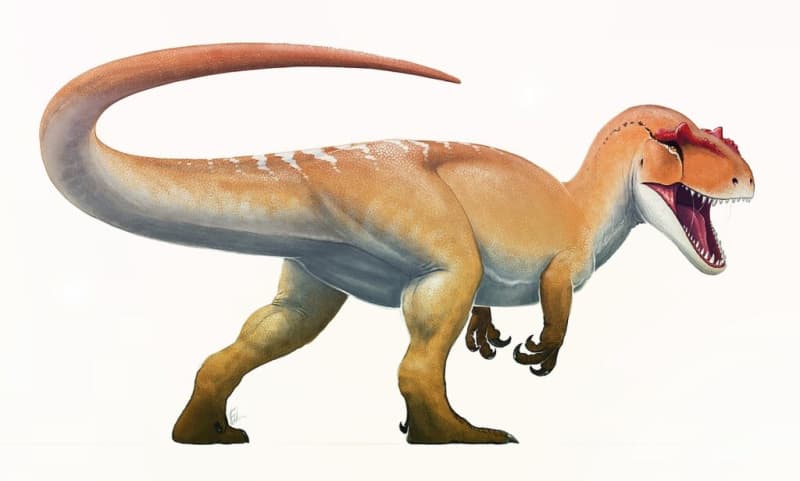
Artist’s reconstruction of Allosaurus. Credit: Fred Wierum/Wikimedia Commons
Allosaurus, the “Lion of the Jurassic”, was one of the most successful predators of its time, present around the world. This popular dinosaur was quite a speedster, estimated to have reached 34 to 53 km/h. Allosaurus‘ strong hind legs and balanced tail suggest that it was capable of quick bursts of speed essential for hunting or conflicts. These physical attributes indicate a predator adapted for high-speed pursuits over short distances, rather than endurance running.
5. Velociraptor: “Swift Thief” (40 km/h)
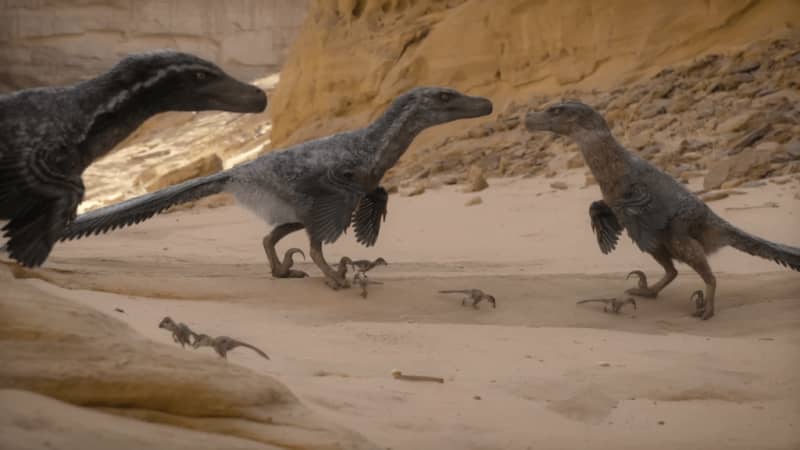
Raptor pack after the hunt. Credit: Prehistoric Planet/Apple+
The famous Velociraptor was considerably smaller than its cinematic portrayal but no less fascinating. Named for its agility and speed, paleontologists estimate that “The Swift Thief” could reach speeds of up to 40 km/h. Characterized by a lightweight frame, a long tail for balance, and a sickle-shaped claw on each hind foot, the Velociraptor specialized in bursts of speed and ambush.
Like most dromaeosaurids, Velociraptor was primarily a carnivore, hunting smaller dinosaurs and possibly scavenging larger carcasses. The combination of its physical speed, agility, and cunning hunting tactics made Velociraptor a successful predator in its environment.
6. Utahraptor: “Utah Thief” (40 km/h)

Artist’s recreation of the coolest raptor, Utahraptor. Credit: Fred Wierum/Wikimedia Commons
Utahraptor was the largest dromaeosaurid. This dinosaur was notorious for its size and power, capable of reaching speeds up to 40 km/h. This ABSOLUTE UNIT lived during the Early Cretaceous period in modern-day Utah and was named as such. Its size and agility made it a top predator in its environment, capable of tackling larger prey.
Equipped with massive sickle-shaped claws on each hind foot and robust limbs, Utahraptor was built for power and speed. These features enabled it to ambush prey with bursts of speed, eventually overpowering them with strength. Utahraptor’s large size, up to 6 meters long, did not hinder its agility, allowing it to dominate its ecological niche effectively.
7. Deinonychus: “Terrible Claw” (40 km/h)
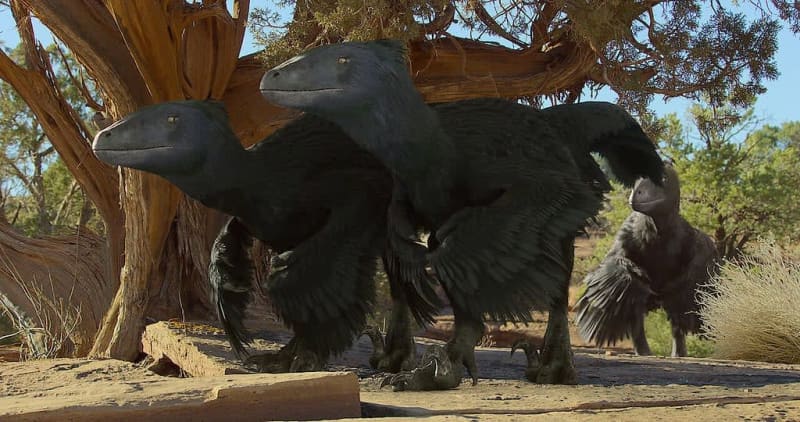
Deinonychus pack on the hunt. Credit: Life on our Planet/Netflix
Deinonychus, one of the largest dromaeosaurids, was known for its fearsome hunting skills and an estimated speed of up to 40 km/h, according to the book Dinosaur Facts and Figures. This speed made it an exceptional predator during Early Cretaceous North America. Deinonychus is often credited with changing the perception of dinosaurs from slow-moving, reptilian giants to agile, active creatures.
This dinosaur was notably equipped with large, retractable sickle-shaped claws on each hind foot, used to slash and grasp its prey. It sported an agile build with a flexible tail used for balance and sharp, curved claws for capturing fast-moving or larger prey. Deinonychus primarily hunted in packs, a behavior suggesting a level of social organization and strategic hunting tactics. The incorrect portrayal of the Jurassic Park Velociraptors is largely based on Deinonychus.
8. Deltadromeus: “Delta Runner” (48 km/h)
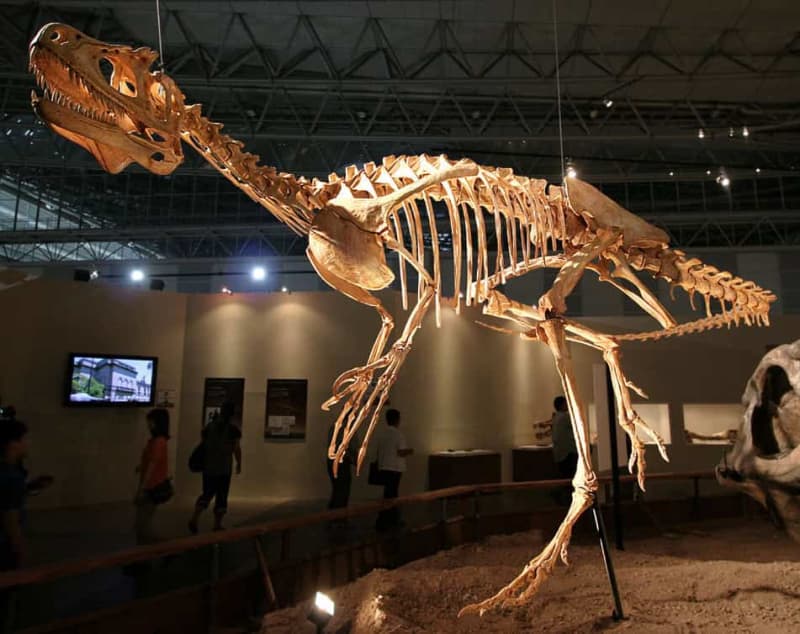
Museum cast of Deltadromeus skeleton. Credit: Wikimedia Commons
Deltadromeus, a name that translates to “delta runner”, was a theropod dinosaur distinguished by its gracile and streamlined body that implies a life on the fast lane. While specific speed estimates are not widely agreed upon, its physical characteristics suggest it could reach up to 48 km/h. Deltadromeus lived in Mid-Cretaceous North Africa.
This dinosaur’s long legs, similar in proportion to those of modern sprinting birds, and a light, lean build would have made it capable of rapid movements, likely facilitating both predation and evasion tactics. Deltadromeus likely preyed on smaller dinosaurs and other animals, using its speed as a primary tool for hunting.
9. Carnotaurus: “Meat Eating Bull” (56 km/h)
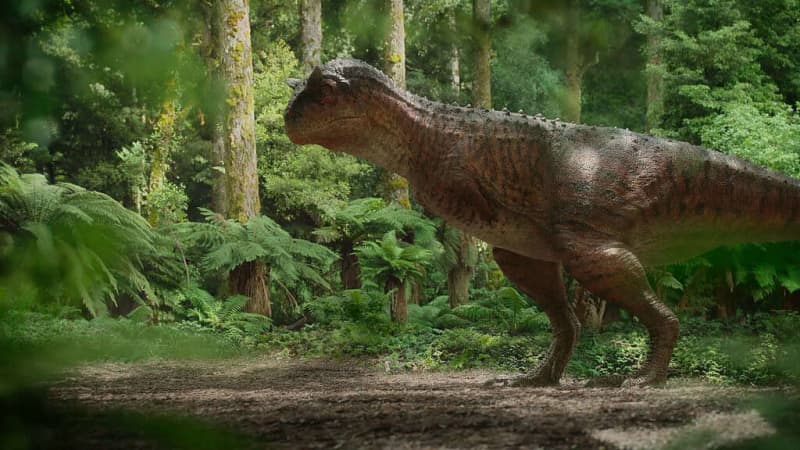
Carnotaurus bull preparing for the mating ritual. Credit: Prehistoric Planet/Apple+
Carnotaurus, distinguished by its bull-like horns, was one of the fastest large theropods, capable of reaching speeds up to 56 km/h. This predator roamed Late Cretaceous South America. Its unique body structure, especially its strong legs and stiff tail, facilitated rapid bursts of speed.
Carnotaurus sported a deep, robust skull and forward-facing eyes with binocular vision. Its arms, among the shortest of any dinosaur, suggest that the genus relied heavily on its ability to charge and overpower prey quickly rather than grappling. The dinosaur’s distinct muscular adaptations supported its ability to sprint to catch up with swift prey or ambush.
10. Gallimimus: “Chicken Mimic” (56 km/h)
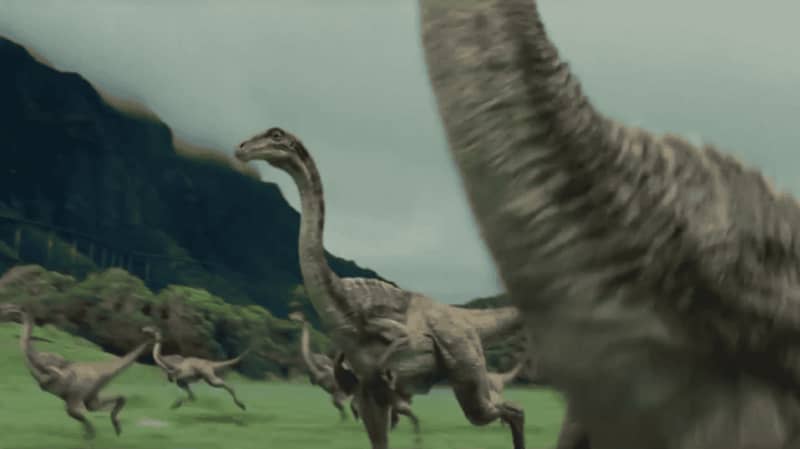
Gallimimus flock speeding through. Credit: Jurassic Park
Gallimimus, the largest “ostrich dinosaur”, reached estimated speeds of up to 56 km/h, according to paleontologist Richard A. Thulborn. Resembling modern ratites in both appearance and capability, this swift dinosaur thrived in Late Cretaceous Mongolia. Its lightweight skeletal structure and long, powerful legs facilitated high-speed sprints. Gallimimus‘ significant speed played a crucial role in its survival strategy, enabling it to escape predators and cover vast territories.
Primarily an omnivore, Gallimimus’ diet likely included a mix of plants, insects, and small vertebrates, which its toothless, beaked mouth was well-suited to snatch up quickly. The versatility in its diet allowed Gallimimus to adapt to various seasonal changes within its environment.
11. Compsognathus: “Pretty Jaw” (60 km/h)
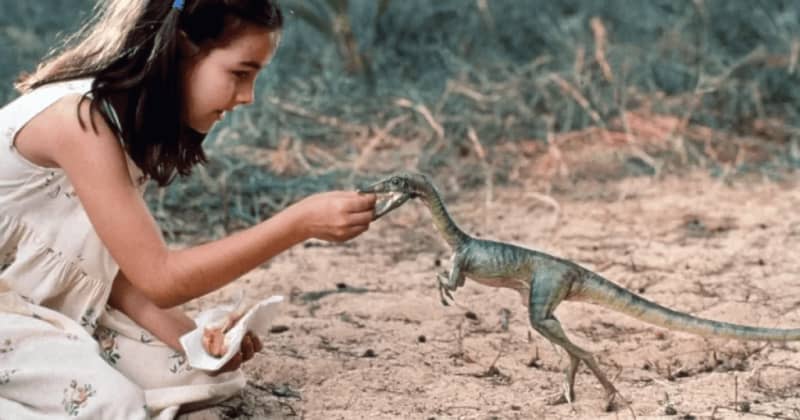
The Lost World’s Compy opening scene. Credit: Jurassic Park
Compsognathus, the “Pretty Jaw”, is known for reaching speeds up to 64 km/h. This tiny theropod from Late Jurassic Europe was one of the smallest dinosaurs, with an adult measuring around one meter long. With a lightweight, streamlined body and long hind legs relative to its size, Compsognathus likely hunted small prey, such as insects and lizards. Its agility would have also been crucial for escaping larger predators.
12. Troodon: “Wounding Tooth” (60 km/h)
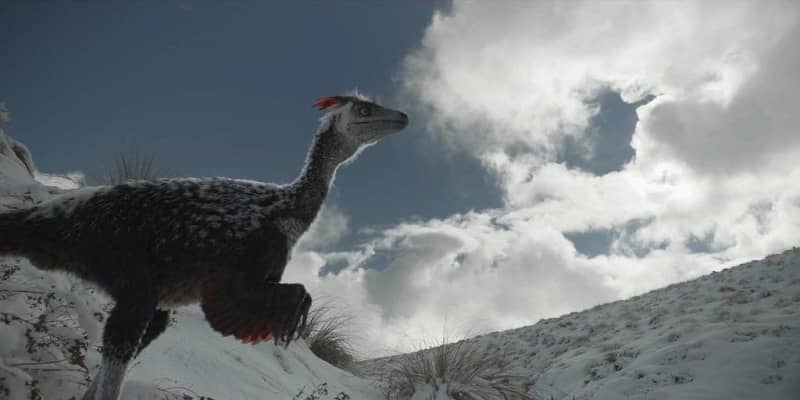
Troodon gone fishing. Credit: Amazing Dinoworld/Curiosity
Troodon is recognized for its remarkable brain-to-body size ratio, making it one of the smartest dinosaurs. However, it was also incredibly fast, with an estimated speed of 60 km/h. This small, bird-like dinosaur thrived during the Late Cretaceous period across what is now North America.
It had long, slender legs and a lightweight build, making Troodon ideally suited for quick movements. The precise nature of its diet remains a topic of debate, but its sharp, serrated teeth suggest a carnivorous diet, possibly supplemented by omnivorous food. The combination of speed, agility, and intelligence allowed Troodon to exploit a variety of ecological niches. It likely used stealth and agility to approach prey and escape predators.
13. Dromiceiomimus: “Emu Mimic” (64 kph)
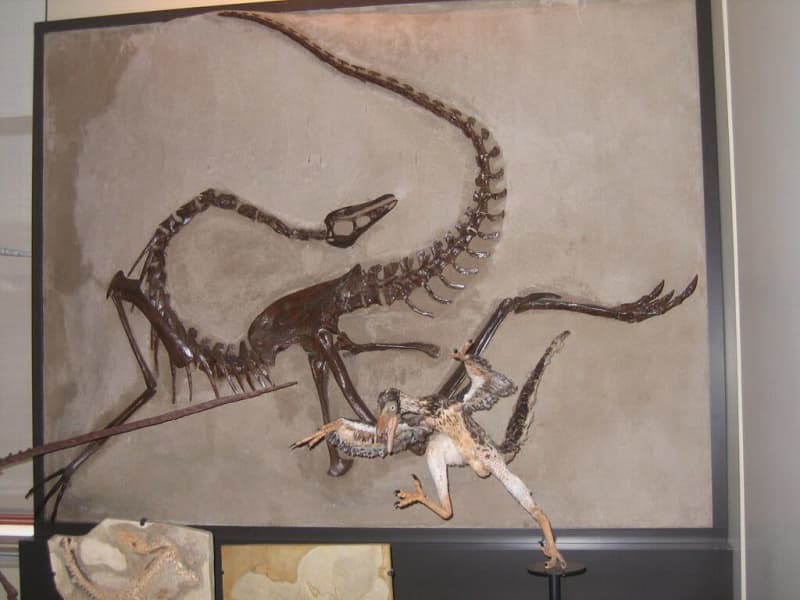
Museum cast of Dromiceiomimus skeleton. Credit: Wikimedia Commons
Dromiceiomimus, often overshadowed by its more famous relatives like the Gallimimus, was another ostrich-like dinosaur known for its remarkable speed, estimated at around 64 km/h. This theropod from Late Cretaceous North America possessed a highly streamlined body that facilitated quick, efficient movements.
With its slender build, long legs, and relatively small head, Dromiceiomimus was adapted for a cursory lifestyle. Its morphology suggests it could have been an excellent distance runner, capable of outpacing predators and swiftly covering large areas to forage for food.
14. Struthiomimus: “Ostrich Mimic” (67 km/h)
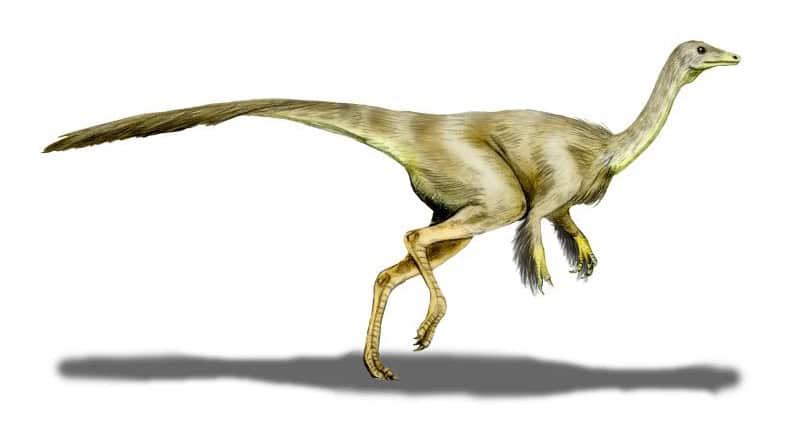
Artist’s recreation of Struthiomimus. Credit: Nobu Tamura/Wikimedia Commons
Struthiomimus, known as the “ostrich mimic”, was another ornithomimid topping this list. With its long legs and lightweight build, it could reach speeds between 50 and 67 km/h. This Late Cretaceous theropod roamed North America’s open plains, utilizing its speed primarily for evasion.
Lacking teeth, Struthiomimus likely fed on a mix of plants, fruits, and insects, easily digestible with its beak-like mouth. The dinosaur’s diet and behavior indicate it was an omnivorous forager.
15. Ornithomimus: “Bird Mimic” (65 km/h)
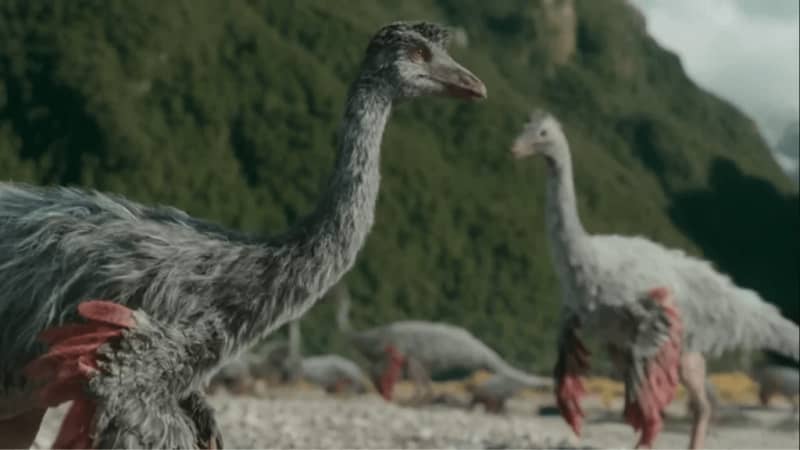
Ornithomimus flock at their nesting grounds. Credit: Prehistoric Planet/Apple+
Ornithomimus, simply the “bird mimic”, was another remarkably fast ornithomimid from Late Cretaceous North America (surprised?). This dinosaur is estimated to have reached speeds of up to 65 km/h. Adults were covered in feathers and could grow up to 4 meters long and weigh up to 170 kilograms. With its long legs, hollow bones, and lightweight build, Ornithomimus was designed for speed and endurance over the open terrain it inhabited.
Ornithomimus was a versatile omnivore, with a diet that likely included leaves, fruits, insects, and small vertebrates. The absence of teeth in its beak-like mouth suggests it might have had a varied diet, feeding on easily swallowed food items. This dietary flexibility, combined with its quickness, allowed Ornithomimus to exploit a range of ecological niches.
16. Nanotyrannus: “Dwarf Tyrant” (65 km/h)
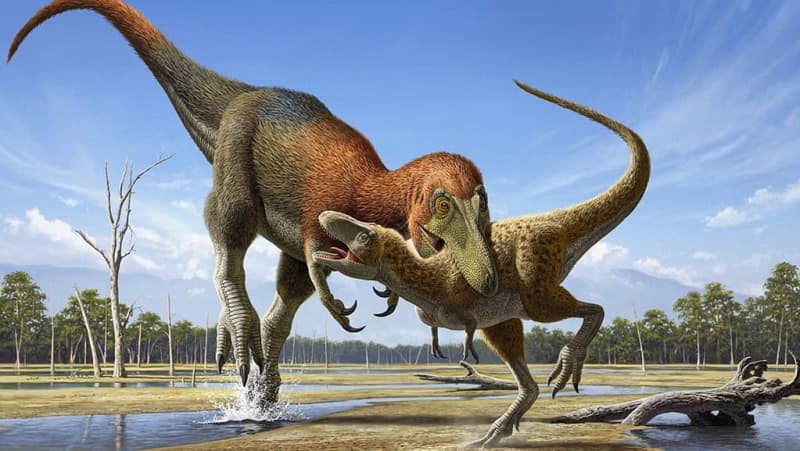
Nanotyrannus attacking a juvenile T.rex. Credit: Raul Martin
Now, I know the Nanotyrannus is a genus whose classification has stirred controversy among paleontologists, put down the pitchforks, please. Scientists still debate whether the genus stands as a distinct species or merely represents juvenile specimens of the T.rex. However, more recent research posits the Nanotyrannus fossils presented signs of adulthood. Moreover, the genus might not even be part of tyrannosauridae.
In 2016, paleontologists at the University of Alberta found the five-meter-long Nanotyrannus was much faster than any Tyrannosaurus, leaving even known juveniles of other tyrannosaur species in the dust.
“In terms of Cretaceous ecology,” says University of Alberta paleontologist Scott Persons, “T. rex was the lion and Nanotyrannus was the cheetah. As far as I’m concerned, it was the scariest dinosaur. Sure, it might take it four to five bites to eat you, whereas T. rex could do it in just one or two, but eaten is eaten—and no dinosaur was better adapted to chase you down.”
Despite the disputes, estimates suggest Nanotyrannus was much faster than Velociraptor, possibly reaching 60-65 km/h. The ongoing research and discovery of new fossil evidence still fuel the debate on its classification, making Nanotyrannus a fascinating case study in dinosaur paleobiology.
Was this helpful?
Thanks for your feedback!
